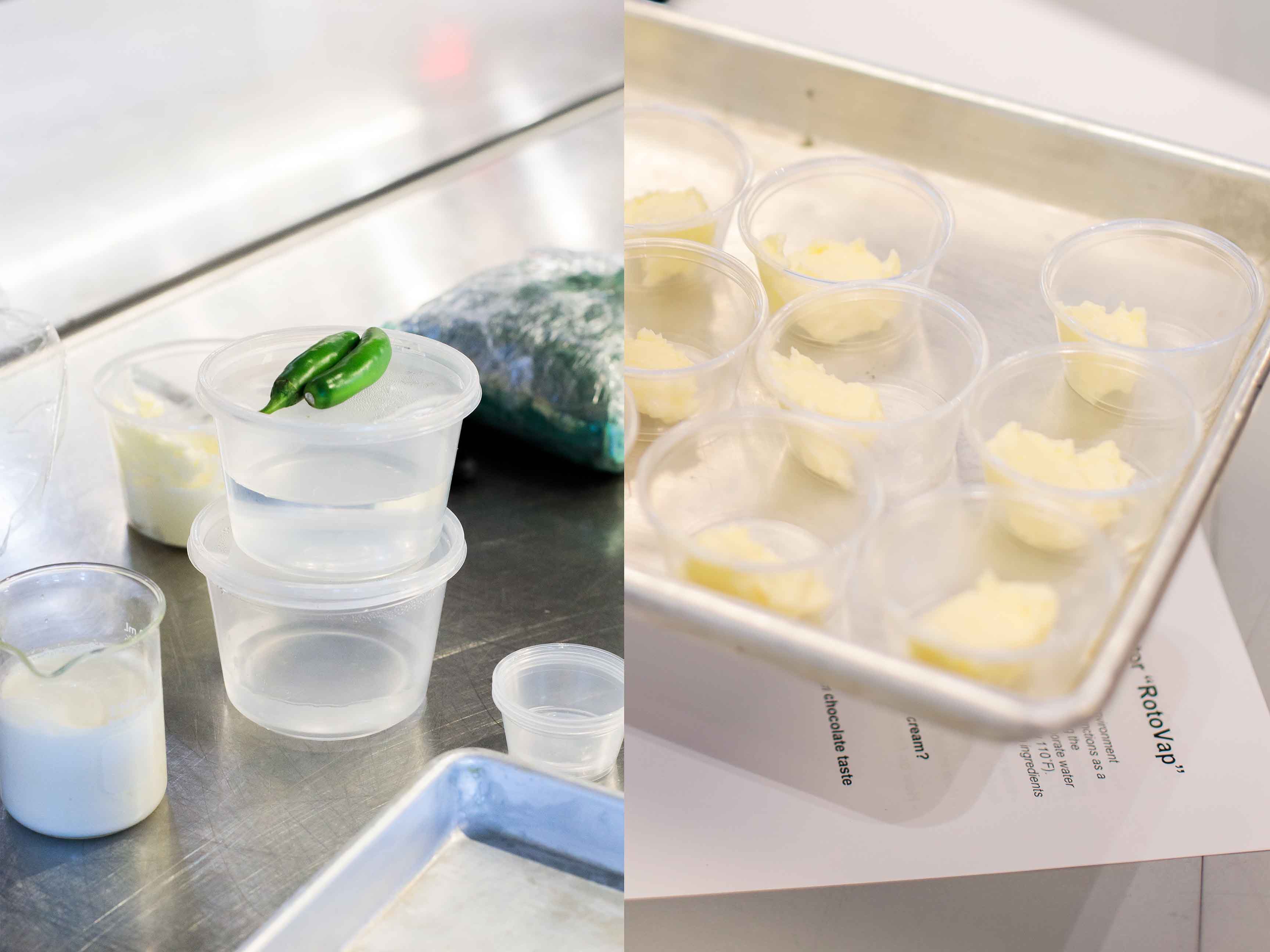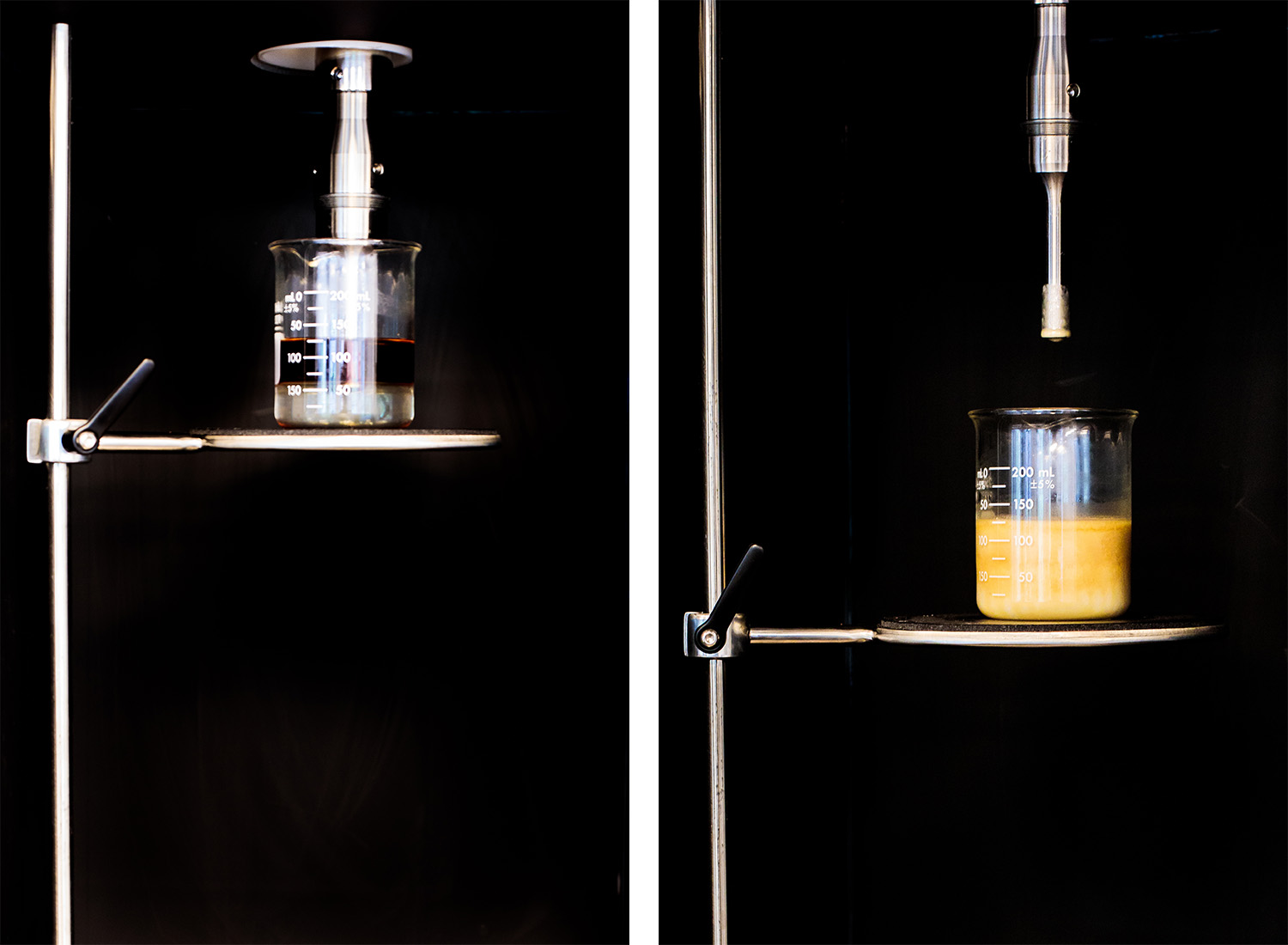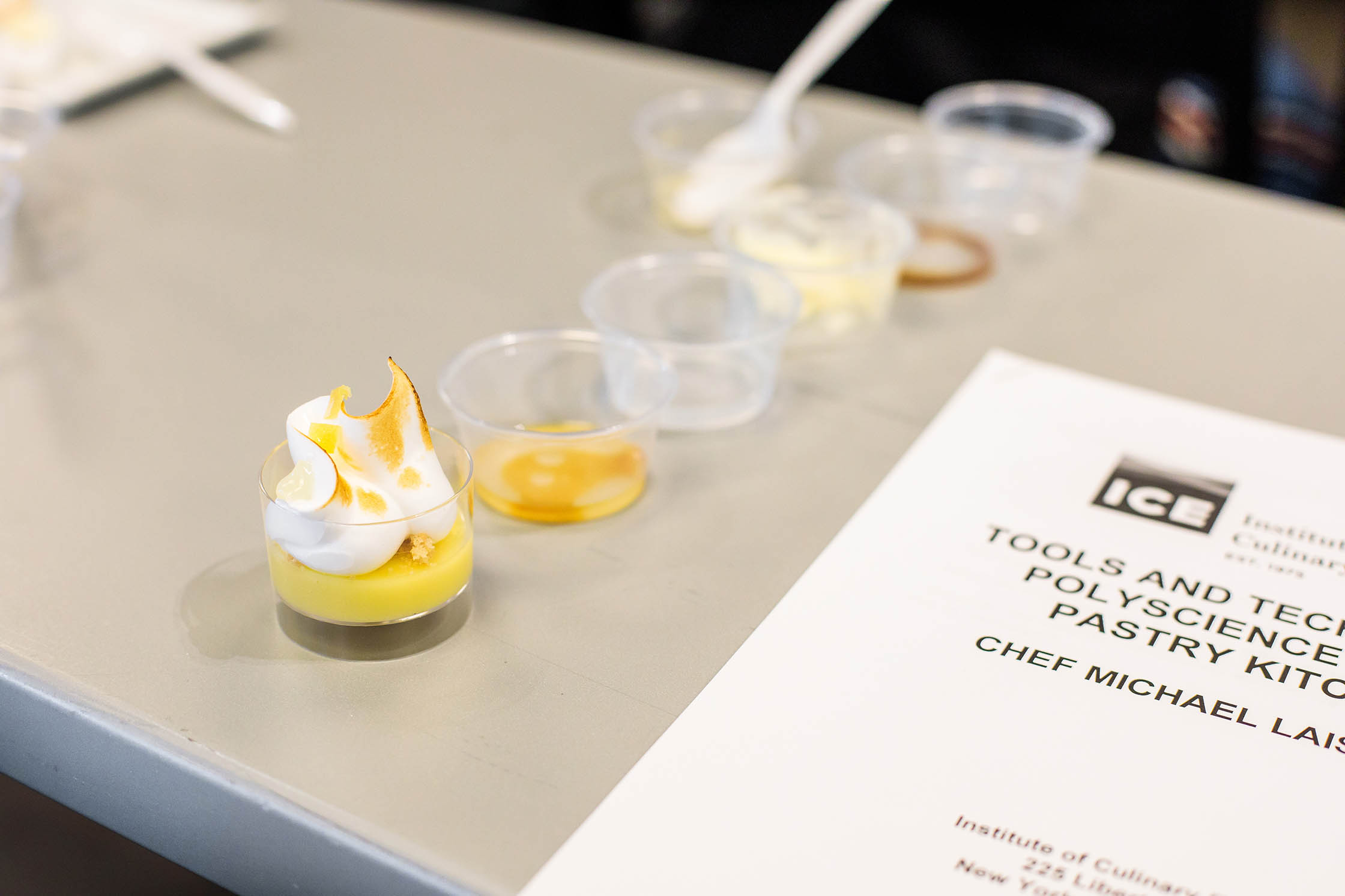If you’ve roamed the main hallway at the Institute of Culinary Education’s New York campus in the last few months, there’s no doubt you’ve noticed a few odd-looking devices on display — contraptions that look like they belong in a chemistry lab more than a kitchen. In fact, these machines were born in the laboratory, but in recent years their role in culinary pursuits has expanded.
Inside these mobile display cases are a rotary evaporator and ultrasonic homogenizer, both secured through the school’s partnership with PolyScience, a key driver of the accessibility and popularity of sous vide cooking techniques. I’ve spent some time getting familiar with these new “toys,” learning some of the basic functions and testing out a few ideas.
Rotary Vacuum Evaporator
We all know that while heat can transform some foods into delicious complexity, in some cases, it can destroy flavor. Put another way: many of the most delicate flavor compounds are volatile and evaporate into the air as we cook. The rotary evaporator allows us to capture, isolate and concentrate those flavors. By heating under a vacuum within a closed system, we can “trap” these volatiles – negative pressure lowers the boiling point and the resulting steam (and flavor) then condenses back into liquid form and is collected. The process may sound complicated and intimidating, but with a bit of trial-and-error I quickly realized how simple the machine’s operations are.
While not exactly standard issue in most kitchens, several innovative chefs have already explored the use of rotary evaporators for years; notable examples include the The Aviary’s “clear” pumpkin pie, in which the rich essence of the classic dish is distilled and transformed into a clear gel, and a twist on surf and turf at Spain’s El Celler de Can Roca, for which the aroma of forest soil was extracted to play as an earthy foil for a briny oyster.
Among my early trials with the rotary evaporator was an exercise with serrano peppers; the fiery heat that we associate with chile peppers (the "capsaicin") is not volatile, so we’re offered a chance to experience the more subtle vegetal notes often hidden behind the burn. Then I turned to chocolate: with the knowledge that acetic acid (to which vinegar owes its kick) can also evaporate at low temperature under vacuum, I was able to distill the volatile sour compounds from ground, roasted cocoa beans. This acidity (a byproduct of fermentation) is something we remove during the chocolate-making process. These acids slowly release into the air, yet rarely are we able to taste them in isolation. (Note: It actually doesn’t taste very good!)

Sometimes we’re after the distillate — the gentle flavors extracted from the base product — but we can also employ the rotary evaporator to concentrate a preparation leaving more of its flavor intact. My love of dairy products compelled me to attempt something like clotted cream, the beloved English accompaniment to scones. By removing some of the moisture from standard heavy cream (again at a much lower temperature than boiling at atmospheric pressure), I was able to produce a thick and silky cream weighing in with a fat content near 55 percent — and without a strong “cooked" taste.
Sonicprep Ultrasonic Homogenizer
Understanding emulsions — stable mixtures of water and fat — is a central element of cooking. Much of our effort as cooks involves creating emulsions (or simply maintaining those that exist), from simple vinaigrettes to silky sauces, or chocolate ganache to complex cake batters. We typically rely on mechanical means to disperse one phase into the other (water into fat or vice versa) to keep them from “breaking.” For some tasks, a whisk will do, for others, a high-speed blender. We can also employ emulsifiers (like the lecithin in an egg yolk) to help preserve emulsions. If we seek what I call a “bullet-proof” emulsion that resists breaking down for longer periods of time, we need to call in something with a bit more power.

Enter the ultrasonic homogenizer. Effortless emulsions are created by ultrasonic waves emitted from a heavy metal probe — essentially buzzing the mixture on a cellular level. Within seconds, one can see a simple mixture of water and oil instantly emulsify. To put this device through its paces, I first created what Modernist Cuisine might refer to as a constructed cream. By combining ground almond butter, water and a touch of almond oil, I was able to achieve a silky almond cream quite similar in viscosity to its dairy-based namesake. Add a bit of sugar and process in an ice machine, and we have an intensely flavored, but dairy-free, almond “gelato.”
The ultrasonic waves can also assist in other applications. To make a quick infusion, the waves disrupt or burst cells to rapidly release flavor, as opposed to longer high-temperature infusions. Here, I employed one of my favorites, an adaptation of a historical drinking chocolate recipe dating back to the 17th century. This complex brew consists of milk with annatto seed, anise, vanilla, cinnamon, hazelnuts, rose, palm sugar and, of course, chocolate. I might typically employ a long slow steep after a brief simmer to coax all of these flavors into the beverage. Theoretically, the homogenizer would allow me to quickly infuse the flavors while cold. The result was similar, but not exactly like the original — some flavors infused more intensely than others, but I look forward to playing with all the variables to perhaps improve and refine the final product.

I love using technology to enhance my basic skills and can’t wait to see what else we can “cook” up. Though once in a great while such advanced tools can lead to new one-of-kind creations, most often they simply help us elevate a classic idea to new heights of flavor and texture. And while much of the focus in the ICE teaching kitchens is on the core fundamentals, offering our students access to these techniques can prepare them for the brave new culinary world of the future.
Explore our career programs to innovate with technology at ICE.




